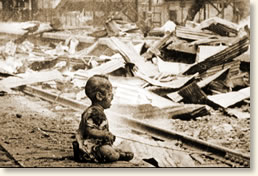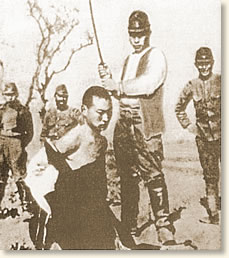|
The Rape of Nanking, 1937
In 1931, the Japanese occupied the Chinese province of Manchuria transforming it into a Japanese puppet state. It was the first step in Japan's drive to control all of China. Six years would elapse before the Japanese took the next step in their plan of conquest.
In early July 1937, Japanese and Chinese troops clashed in Peking in an incident at the Marco Polo Bridge. Using this as justification, the Japanese launched a full-blown assault on the city at the end of the month utilizing massed infantry, tanks and airstrikes. It did not take long for the city and the surrounding area to fall to the Japanese.
 |
The Japanese destroy the railway
station at Shanghai, August 1937
This photo prompted a world outcry.
|
The fighting moved to the south in August when the Japanese attacked Shanghai and pursued the retreating Chinese army up the Yangtze valley to the national capital at Nanking. The Japanese began their attack on that city early in December, forcing its surrender on December 13. Then the horror began.
The population of Nanking was subjected to an uncontrolled butchery that came to be known as "the Rape of Nanking." As the Japanese army poured into the city, fleeing residents were shot or bayoneted. Thousand of suspected members of the Chinese Army who had shed their uniforms for civilian clothing, were apprehended, their hands tied behind their backs and led en mass to killing fields where they were shot, beheaded, used for bayonet practice or killed in some other gruesome manner before being dumped into mass graves. Thousands of others were buried while still alive. Rape was rampant as thousands of women were repeatedly forced into brutal sex and often murdered once the lust of their attackers had been satisfied. The carnage lasted for six weeks and took an estimated 40,000 lives.
John Rabe was a German businessman who had resided in China since 1908. He represented the China branch of the Siemens Company and lived in Nanking at the time of the Japanese invasion. As the Japanese approached, he joined other foreign nationals in establishing a “Safety Zone” within the city that would harbor only civilians and unarmed soldiers. It was hoped that, devoid of combatants, the Japanese would spare the Safety Zone.
John Rabe kept a diary of his experiences. We join his story on the day that the Japanese enter the city and he accompanies other members of the Safety Committee in a tour of the Safety Zone:
"December 13, 1937
Three of us committee members drive out to military hospitals that have been opened in the Foreign Ministry, the War Ministry, and the Railway Ministry, and are quickly convinced of the miserable conditions in these hospitals, whose doctors and nurses simply ran away when the shelling got too heavy, leaving the sick behind with nobody to care for them. . .
The dead and wounded lie side by side in the driveway leading up to the Foreign Ministry. The garden, like the rest of Chung Shan Lu, is strewn with pieces of cast-off military equipment. At the entrance is a wheelbarrrow containing a formless mass, ostensibly a corpse, but the feet show signs of life.
It is not until we tour the city that we learn the extent of the destruction. We come across corpses every 100 to 200 yards. The bodies of civilians that I examined had bullet holes in their backs. These people had presumably been fleeing and were shot from behind.
 |
John Rabe
|
The Japanese march through the city in groups of ten to twenty soldiers and loot the shops. If I had not seen it with my own eyes I would not have believed it. They smash open windows and doors and take whatever they like. Allegedly because they're short of rations. I watched with my own eyes as they looted the cafe of our German baker Herr Kiessling. Hempel's hotel was broken into as well, as was almost every shop on Chung Shang and Taiping Road. Some Japanese soldiers dragged their booty away in crates, others requisitioned rickshas to transport their stolen goods to safety.
...Forster (Ernest Forster, an American theologian) surprises some Japanese soldiers who are about to steal his bicycle but vamoose when they spot us. We stop a Japanese patrol, and point out to them that this is American property and ask them to order the looters to leave. They simply smile and leave us standing there.
We run across a group of 200 Chinese workers whom Japanese soldiers have picked up off the streets of the Safety Zone, and after having been tied up, are now being driven out of the city. All protests are in vain.
Of the perhaps one thousand disarmed soldiers that we had quartered at the Ministry of Justice, between 400 and 500 were driven from it with their hands tied. We assume they were shot since we later heard several salvos of machine-gun fire. These events have left us frozen with horror.
...Mr. Han says that three young girls of about 14 or 15 have been dragged from a house in our neighborhood. Doctor Bates reports that even in the Safety Zone refugees in various houses have been robbed of their few paltry possessions. At various times troops of Japanese soldiers enter my private residence as well, but when I arrive and hold my swastika armband under their noses, they leave. There's no love for the American flag. A car belonging to Mr. Sone, one of our committee members, had its American flag ripped off and was then stolen.
December 16
All the shelling and bombing we have thus far experienced are nothing in comparison to the terror that we are going through now: There is not a single shop outside our Zone that has not been looted, and now pillaging, rape, murder, and mayhem are occurring inside the Zone as well. There is not a vacant house, whether with or without a foreign flag, that has not been broken into and looted.
...No Chinese even dares set foot outside his house! When the gates to my garden are opened to let my car leave the ground… women and children on the street outside kneel and bang their heads against the ground, pleading to be allowed to camp on my garden grounds. You simply cannot conceive of the misery.
 |
The Japanese prepare
to behead a victim
|
I've just heard that hundreds more disarmed Chinese soldiers have been led out of our Zone to be shot, including 50 of our police who are to be executed for letting soldiers in. The road to Hsiakwan is nothing but a field of corpses strewn with the remains of military equipment. The Communications Ministry was torched by the Chinese, the Y Chang Men Gate has been shelled. There are piles of corpses outside the gate. The Japanese aren't lifting a hand to clear them away, and the Red Swastika Society associated with us has been forbidden to do so.
It may be that the disarmed Chinese will be forced to do the job before .. they're killed. We Europeans are all paralyzed with horror. There are executions everywhere, some are being carried out with machine guns outside the barracks of the War Ministry.
...As I write this, the fists of Japanese soldiers are hammering at the back gate to the garden. Since my boys don't open up, heads appear along the top of the wall. When I suddenly show up with my flashlight, they beat a hasty retreat. We open the main gate and walk after them a little distance until they vanish in the dark narrow streets, where assorted bodies have been lying in the gutter for three days now. Makes you shudder in revulsion.
All the women and children, their eyes big with terror, are sitting on the grass in the garden, pressed closely together, in part to keep warm, in part to give each other courage. Their one hope is that I, the 'foreign devil' will drive these evil spirits away."
References:
This eyewitness account appears in: Rabe, John, The Good Man of Nanking, Erwin Wickert (ed.) (1998); Chang, Iris, The Rape of Nanking (1998).
How To Cite This Article:
"The Rape of Nanking, 1937" EyeWitness to History, www.eyewitnesstohistory.com
(2009).
|






